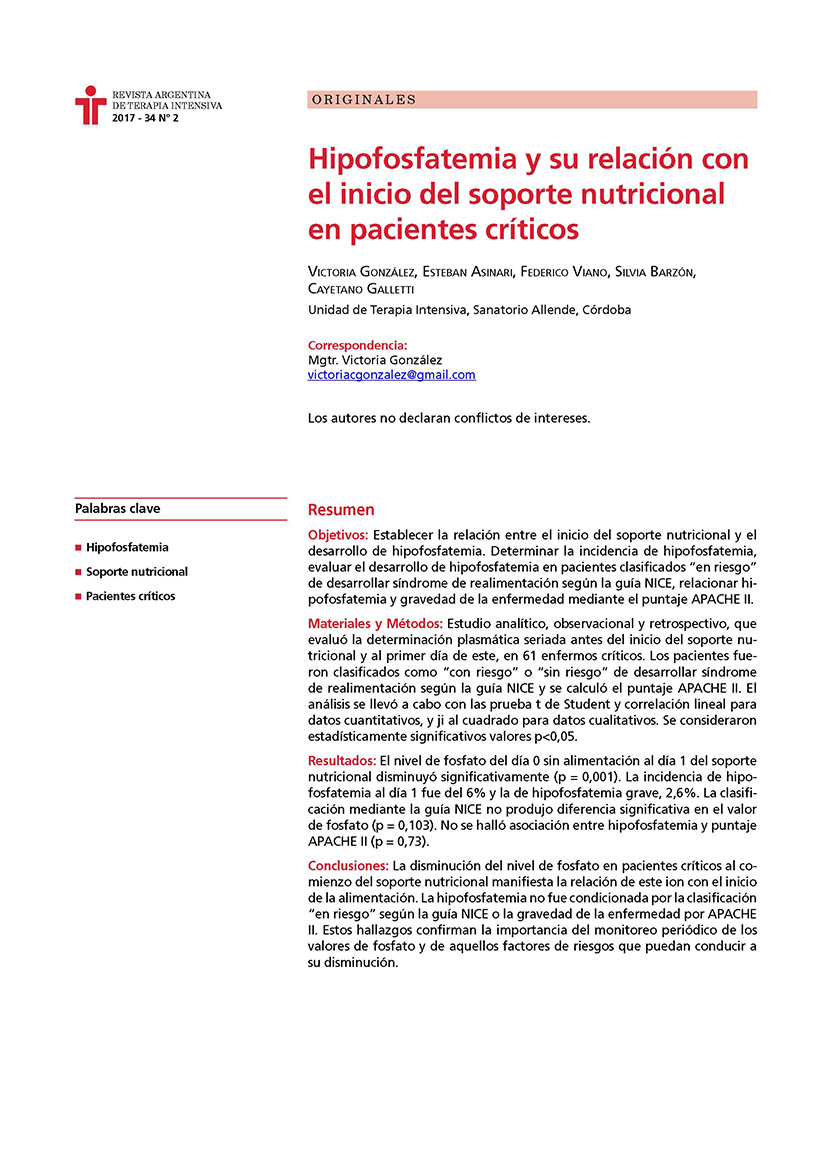Resumen
OBJETIVOS: Establecer la relación entre variación del fosfato e inicio del soporte nutricional. Determinar incidencia de hipofosfatemia. Analizar el desarrollo de hipofosfatemia en pacientes clasificados "en riesgo" de desarrollar síndrome de realimentación según guía NICE (National Institute For Clinical Excellence). Determinar asociación entre hipofosfatemia y severidad de la enfermedad a través del cálculo de APACHE II (Acute Physiology and Chronic Health Evaluation II).
MATERIAL Y MÉTODO: Estudio retrospectivo, analítico, observacional que evaluó el laboratorio seriado antes del inicio del soporte nutricional (SN) y al primer día de éste, en 61 pacientes críticos. Se los clasificó en, "con riego" o "sin riesgo" de desarrollar síndrome de realimentación (SR) según guía NICE y se calculó APACHE II. Para el análisis de los datos cuantitativos se utilizó Test T de Student y regresión lineal; Chi2 para datos cualitativos. Se consideraron estadísticamente significativos valores de p<0,05.
RESULTADOS: El nivel de fosfato del día 0 sin alimentación, al día 1 del SN disminuyó significativamente (p=0,001). La incidencia de hipofosfatemia al día 1 fue del 34% e hipofosfatemia severa 15%. La clasificación por guía NICE no produjo diferencia significativa en el valor de fosfato (p=0,103). No se encontró asociación entre hipofosfatemia y valor de APACHE II (p=0,73).
CONCLUSIÓN: La disminución del nivel de fosfato encontrada en pacientes críticos al comienzo del SN, manifiesta la relación de este ion con el inicio de la alimentación. La hipofosfatemia no fue condicionada por la clasificación "en riesgo" según la guía NICE o la severidad de la enfermedad por APACHE II. Estos hallazgos confirman la importancia del monitoreo periódico de los valores de fosfato y de aquellos factores de riesgos que puedan conducir a su disminución.
Palabras claves: hipofosfatemia, soporte nutricional, pacientes críticos.
OBJECTIVES: To establish the relationship between variation of phosphate and start of nutritional support. Determine incidence of hypophosphatemia. Analyze the development of hypophosphatemia in patients classified "at risk" of RS according to NICE (National Institute For Clinical Excellence) guide. Hypophosphatemia and severity disease association through the calculation of APACHE II (Acute Physiology and Chronic Health Evaluation II).
MATERIALS AND METHODS: A retrospective, analytical, observational study that evaluated the serial laboratory before the nutritional support (NS) and the first day of it in 61 critically ill patients. They were classified in, "at risk" or "not at risk" of developing refeeding syndrome (SR) according to NICE guide and APACHE II. For the analysis of quantitative data Student t test and linear regression was used; Chi2 for qualitative data. They were considered statistically significant p <0.05.
RESULTS: Phosphate level without food on day 0 to day 1 NS decreased significantly (p = 0.001). The incidence of hypophosphatemia to day 1 was 34% and 15% severe hypophosphatemia. NICE guideline classification produced no significant difference in the value of phosphate (p = 0.103). No association between hypophosphatemia and APACHE II (p = 0.73) was found..
CONCLUSION: The decreased level of phosphate found in start of NS in critically ill patients, shows the relationship of this ion to the start of feeding. Hypophosphatemia was not conditioned by the classification "at risk" according to the NICE guide or the severity of the disease by APACHE II. These findings confirm the importance of regular monitoring of phosphate values and those risk factors that could lead to its decline.
Keywords: hypophosphatemia, nutritional support, critically ill patients.
La revista no retiene los derechos de reproducción (copyright) por lo que los autores pueden volver a publicar sus trabajos con la sola mención a la fuente original de publicación.

